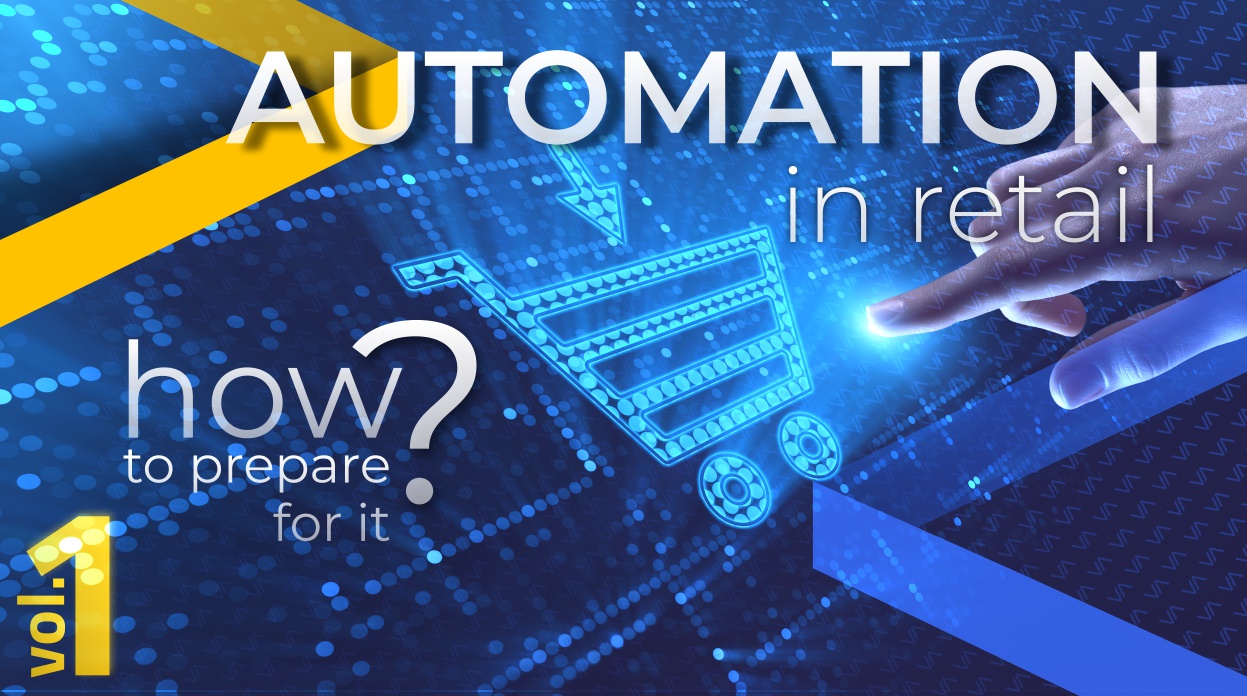Automation in retail: how to prepare for it? - Part 1

September 4, 2020 | #selfevolution academy
Retailers have tough nut to crack nowadays. From every angle they are attacked by growing costs of side services (like deliveries, infrastructure, materials, staff) and at the same time expectations of customers are harder and harder to meet. One of possible ways to cope with all the obstacles is automation – transferring some of the operations to smart, autonomic software and robots.
As research shows, even though about half of processes in retail industry is possible to automate, it will not pose a threat for employees and their workplaces. It is more like proper managing of workforce, what means creating new jobs, transforming them and retraining staff for another positions, especially these which need creative or “outside the box” thinking and emotional approach.
Let’s discuss four aspects which show how situation of automation in retail processes looks now.
Impasse in retail
Retail sector is one of the fastest growing ones. Together with its development, comes fiercer competition. Together with competition comes price war. But independly from prices, comes increase in raw material cost, delivery cost, management cost, employee pay rise expectations. That all have effect on lowering margins what decreases businesses revenue and profitability. Sooner or later it all comes to a point of no return. Costs are growing, and only way is lowering them or transferring them on clients. Second way leads to becoming uncompetitive, so new ways of expenses reduction are needed. One of them is automation.
The problem touches all subsectors of retail industry, but biggest margin pressure is faced by specialistic apparel and department stores. Advanced and well implemented automation plan can reduce this pressure drastically, allowing to transfer saved funds to other investment areas.
Change is hard, but worth it
Today’s technology allows to run a typical grocery store using less than half of the time and workforce it needs now, what as confirmed, can greatly improve financial effects, return rates and even employee satisfaction, but still majority of the retailers struggle to give it a try. We can use robots and electronic smart devices for automatic checkout, for scanning shelves in search of incorrectly placed goods or outdated ones, for robotized storaging or even autonomic cleaning. So why not to use them? Of course these technologies are advanced and their cost is not low. Implementation of it is also complicated and needs proper infrastructure. That all is the main problem especially for smaller entities, but there are many large corporations who still are resistant.
Often problem lies in psychology. It is easy, convenient and more secure to stick with old, proven solutions, and to copy strategies from previous years. But thinking that budget and investments plan, which were successful year before, will be the same now, is the misconception. Those who stay in one place, are really making a step back. Dynamic development and adapting to new situations is the key. Large majority of the companies don’t act vividly enough, and only about 30 percent are reacting properly. Dynamic decision making and adjusting to the market look well also for investors and shareholders. As data show, companies who act dynamically have better perspectives on stock market results.
Falling behind leads to losing the race
Automation is happening right now. It is the train, that’s about to go, leave the station and reach full speed soon. Some retailers took first steps towards it, by experimenting with autonomic technologies and trying to implement them to their stores. Those who fail to keep up will be left behind by the ruthless competition.
The field of automation in retail is led by Amazon, which under the brand “Amazon Go” introduced fully automated grocery stores. For now, there are over 20 of them in four American cities (Seattle, Chicago, San Francisco and New York), but thousands of them are planned to open in following years. In todays world driven by continuous lack of time, premises without queues and with personalized assortment and promotions will always be needed.
Another example of automation supported by AI are “Kroger Edge” digital shelves (implemented in over 200 stores in 2018). What is special about them? Kroger Edge are miniaturized screens, which serve as price labels with additional functions like presenting nutrition facts, discount coupons and video advertisements. Of course there are also actions aimed at replacing physical workers by robots. Autonomic, mechanical employees can now clean surfaces or automatically manage stores backrooms.
E-commerce can also take profits from automation and Ahold Delhaize or Albertsons are perfect example of it, with their automated, robotic order fulfillment centers and autonomic warehouses. And that all is just the beginning, more applications certainly coming soon.
Automation + artificial intelligence = effective managing
Previous sections were focused mostly at automation in stores themselves, but the most important actions take place higher, in corporations’ headquarters. With modern technologies there is lot to improve in merchandising or HR departments. Different smart solutions based on artificial intelligence and deep learning can carry out planning operations, historical analysis with future scenarios creation or marketing action designing process. Forwarding all these efforts to smart software lets spare huge amount of time. Limiting the time spent on activities that can be automated give the opportunity to use human resources more productively, on tasks which demand more strategic or abstract thinking.
Personnel strategy can also benefit from the assistance of automation, and both HR departments and potential job candidates will feel the improvement. Transferring recruitment process to specialized apps massively simplifies whole process. Before, applying for job was equal to numerous visits in company headquarters, tones of required documents, exhausting paperwork. Lot of time and nerves spent inefficiently. With intelligent recruitment system things are easier. Candidates have possibility to scan job offers, apply and send all required papers online, and HR got a tool to check, identify and verify potential job applicants. Time saving is proven to be as high as 80% and quality of hired workers increased thanks to advanced analysis algorithms.
So, what actions to take now?
After lecture of text above you should be aware of present situation in retail automation concept. In one of the future articles we will present some useful management strategies that implementing of which should be considered in order to be ready for upcoming retail revolution.










